 |
 |
The Graphic [London]
August 7, 1880
| The western border of British India was defined during the colonial period by three wars with Afghanistan. These wars were part of The Great Game with Czarist Russia for control of Central Asia. During the Second Afghan War, on July 27th, 1880, the British Indian army suffered one of its worst defeats ever. The Battle of Maiwand in south-western Afghanistan near Kandahar led to the rout of General Burrow's Bombay Sepoys by Ayub Khan. This issue of The Graphic appeared just as the stunning news of the defeat hit London. The name of the battle site was not even known. |
| Abdur Rehman Khan consolidated his postion as Amir soon after the Battle of Maiwand; his rival Ayub Khan was quickly defeated after General Robert's infamous non-stop, three-day march of Sikh and Pathan troops from Kabul to Kandahar. The Amir was neither friend nor foe to the British. He ruled Afghanistan stably for many decades, and established the modern boundaries of the country. |
 | The Amir's portrait was made from a photograph by John Burke, a photographer of Peshawar and Murree in the Punjab. It was one of hundreds of photographs he made of the Second Afghan War from 1878-1880. |
| Beneath the Amir's portrait on the front page of The Graphic was half of a Burke winter panorama of the Bala Hissar, the main fort in Kabul where the Amir lived and from where the first Mughal Emperor Babar had launched his invasions of India. | |